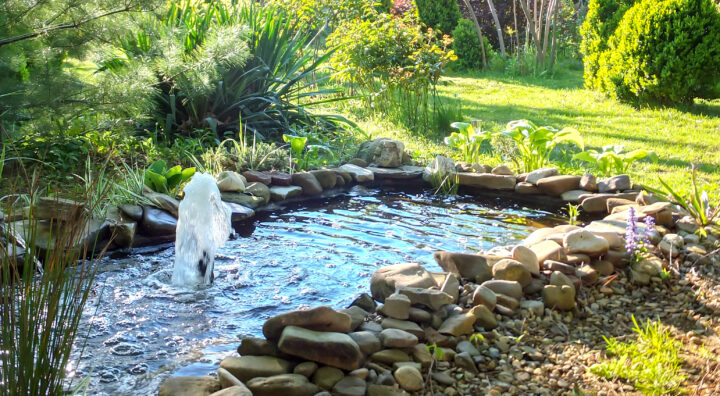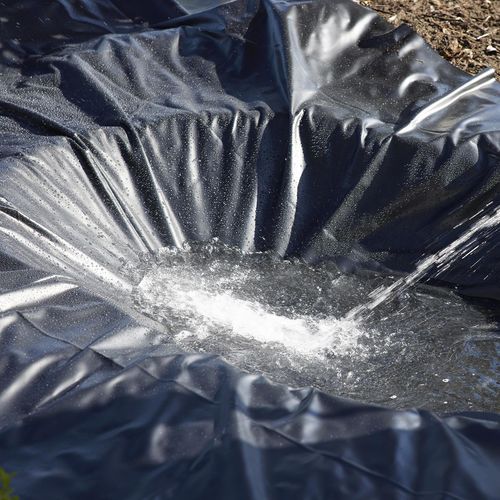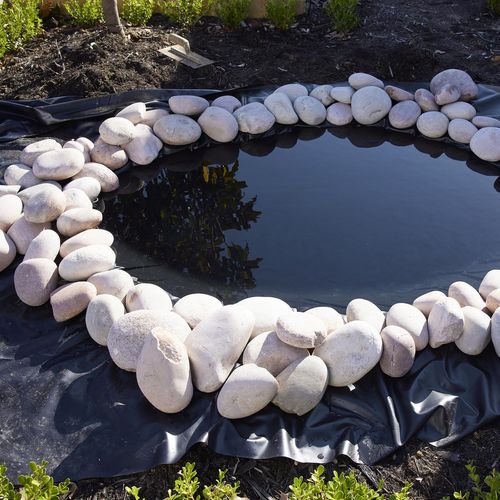
Ponds stand as a serene oasis in both urban and countryside settings and at the heart of their beauty lies a key component: the pond liner.
This component not only determines the pond’s longevity, it’s also the guardian of your water feature, safeguarding the health and aesthetics of the aquatic environment. Aquapro provides a comprehensive selection of pond system solutions for those in the market for a pond liner.
The Various Types of Pond Liners
EDPM vs. PVC Pond Liners: Which One Should You Choose?
Pond liners are essential for creating and maintaining a stable pond environment, one that’s free from leaks and seepage. The two most common materials used for pond liners are EPDM (Ethylene Propylene Diene Monomer) and PVC (Polyvinyl Chloride).
EDPM Pond Liners
Firstly, let’s discuss EPDM liners.
- Pros:
- Durability: EPDM liners are renowned for their robust nature. They are resistant to UV damage and harsh weather conditions.
- Flexibility: Even in colder temperatures, EPDM retains flexibility, making it easier to mould around your pond’s unique shapes and corners.
- Long lifespan: If properly maintained, an EPDM liner can last for more than 20 years.
- Cons:
- Weight: They tend to be heavier than PVC liners, making them slightly more challenging to install, especially for larger ponds.
- Cost: Generally, EPDM is more expensive than PVC on a per-square-metre basis.
- Requires underlayment: To prevent punctures, an underlayment is usually recommended beneath the EPDM liner.
PVC Pond Liners
Now, let’s delve into PVC pond liners.
Pros:
-
- Cost-effective: PVC pond liners in Australia are generally more affordable than EPDM liners. This makes them an attractive option for those on a tighter budget.
- Lightweight: Being lighter than EPDM, PVC liners are easier to handle and install, especially for solo DIY projects.
- Versatility: PVC liners are available in various sizes, allowing you to choose the best one based on the size and depth of your pond.
- Easier Seaming: If you have a larger pond and require multiple sheets, PVC liners can be fused together more effortlessly than EPDM.
Cons:
-
- UV sensitivity: PVC can become brittle and degrade faster under prolonged UV exposure however quality modern PVC liners now come with UV inhibitors to reduce this effect. Aquapro PVC Pond Liners are known for their durability, flexibility and strength and are UV stabilised for our Australian climate.
- Lifespan: While PVC liners are durable, they may not last as long as EPDM liners, typically around 10-15 years with proper care. With Aquapro’s 10-year UV guarantee on PVC Pond Liners, you can feel confident in the longevity of your purchase.
So to summarise, while both EDPM and PVC pond liners have their place in pond construction, if you’re looking for a more budget-friendly option that’s easier to handle and install, then PVC might be the way to go. It’s crucial, however, to weigh your needs, the size of your project, and your budget before making a decision. Whichever material you choose, proper installation and maintenance are key to ensuring your pond remains a beautiful and leak-free oasis for years to come.
When to Consider Replacing your Pond Liner
If you already have a pond liner and are considering replacing or upgrading it, here are the main reasons to consider a new PVC pond liner:
- Age: If your liner is approaching the end of its typical lifespan and is showing signs of wear, it might be time to consider replacement.
- Frequent repairs: If you find yourself constantly patching up leaks or addressing other damage, it could be more cost-effective, in the long run, to replace the liner rather than continuously repair it.
- Structural damage: If there’s extensive tearing, large sections of UV damage, or significant deformation, a simple repair might not suffice. In these cases, a full replacement is the safer choice.
- Redesigning the pond: If you’re considering enlarging your pond or significantly altering its shape, this is a good time to choose a new liner tailored to the new design.
Factors to Consider When Choosing a PVC Pond Liner
You’ll want to feel confident in your choice of pond liner,
- Pond size and depth: The larger and deeper your pond, the more robust and durable your liner material should ideally be. The liner’s dimensions also play a crucial role in determining the material type. Aquapro PVC Pond Liners are durable, strong and flexible and come pre-cut in 3 x 2 m to 5 x 4 m sizes suitable for creating ponds from 600L to 3600L in volume.
- Pond shape and design intentions: If you’re eyeing a uniquely shaped pond, perhaps inspired by a particular theme, flexible liners are your best bet. They can conform to intricate contours and design nuances with ease.
- Local climate and weather conditions: Places with high UV intensity or regions that frequently see freezing temperatures necessitate liners that can withstand these specific challenges. Aquapro PVC Pond Liners are UV-stabilised, durable and robust to suit our Australian climate extremes.
- Budget constraints: Financial considerations are pivotal. However, it’s essential to strike a balance between cost-effectiveness and long-term durability. PVC pond liners provide the best of both worlds with a budget-friendly price and a 10-year lifespan.
Installation and Maintenance Tips for Pond Liners



Here are our top tips for installing and maintaining your impressive new pond:
- Preparing the pond site: Dedicate time to meticulously clear the intended pond area of any potential threats, such as sharp stones or debris. Expert tip – we recommend laying a rope out first to plan the shape of the pond. You’ll need to grab a shovel for this project to dig a hole the size you want the pond to be.
- Techniques for laying flexible liners: Mindful handling is crucial to ensure the liner doesn’t get damaged during installation. It’s also vital that it has minimal creases and that it stretches adequately to cover the pond’s dimensions.
- Add weight: You’ll want to add heavy rocks or pavers to the edges to ensure that the pond liner is well anchored.
- Fill the pond: Grab a hose and start filling the pond up with water. Once filled, you should allow it to settle for a minimum of 7 days, then you can trim the edges of the PVC liner. We recommend adding a submersible pump to keep the water fresh. You may also want to consider a water feature for that extra wow factor.
- Maintenance Routines: Seasonal checks, combined with clearing any accumulated debris or algae, can keep your liner in pristine condition and enhance its lifespan. Aquapro has a range of pond care products ideal for keeping your oasis at its best.
Check out our expert guide on calculating pond volume, liner size, full installation and pond liner edge treatment methods.
The journey to selecting the right pond liner is one filled with many considerations. However, the effort invested in this process directly influences the enduring beauty, health, and vibrancy of your pond. As you navigate these decisions, remember that the right liner not only shapes the pond’s present but fortifies its future. Aquapro is the premier choice for PVC pond liners in Australia, reach out to us for any queries that you may have.
